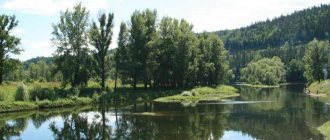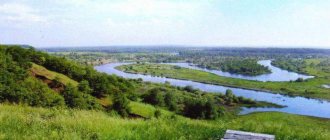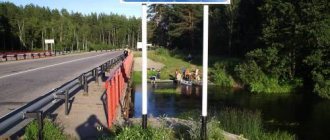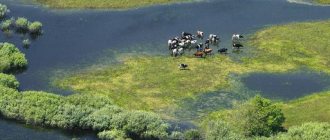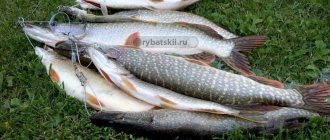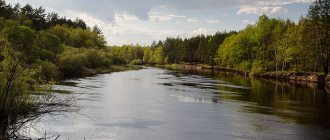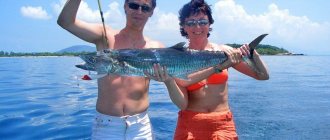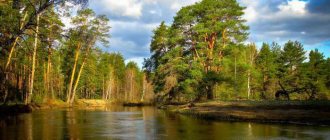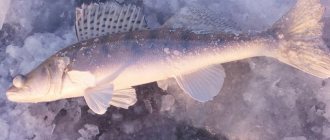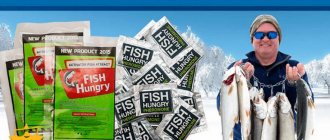The persistent Mzymta carries its waters to the Black Sea coast of the Krasnodar Territory. The river has a difficult character, which is very popular with rafting enthusiasts. Its picturesque shores do not leave tourists indifferent, and cold waters can not only bring pleasure from rafting, but also provoke man-made accidents. It is this obstinate beauty that today’s story will be about.
Short description
In Russia, the Mzymta River is one of the largest waterways flowing into the Black Sea. On average, every year it releases about 1.4 km³ of fresh water into the depths of the sea. The river is more than 89 km long and its drainage basin covers 885 km².
The source of the river should be sought on the slopes of the Main Caucasus Range, at an altitude of more than 2400 m (the base of Mount Loyub). The upper reaches of the Mzymta River feed the high-mountain lakes Maly Kardyvach and Kardyvach. Below the lakes, a strong stream forms a waterfall, the height of which is 15 m. It is called Emerald. Then the stream picks up speed and rushes on. The path of the middle river bed passes through the Aibga-Achishkho ridge, creating a picturesque Greek gorge. Downstream are the Akhtsu and Akhshtyrskoye gorges.
Further, the Mzymta River in Adler flows into the Black Sea, forming a large alluvial cone at its mouth. It consists of loose debris and broken rocks.
The Mzymta channel is weakly branched, but very winding. The banks are ledges of terraces, the depth of which is about 10 m. At the source and in the upper reaches there is a V-shaped valley. The slopes have a steepness of up to 35°, but in some places they are much steeper - up to 50°. Along the entire channel they are divided into deep gullies and valleys. The upper part of the channel has a rocky bottom with large boulders, while the middle and lower part is characterized by a pebble-boulder and pebble bottom.
The mouth of the Mzymta River is located on the Adler Lowland. Here the waterway enters a wide valley with slight slopes. In the upper and middle reaches, the river is characterized by large fluctuations in water level; the annual amplitude can be 2.32 m. Closer to the mouth, this figure becomes smaller. The Mzymta River in Adler usually does not rise higher than 2.23 m during the year.
Paid fishing on the most interesting rivers in Sochi
You have a choice - look for free “fishing” places or find out prices for fishing on the river in Sochi. Most choose the second option as more comfortable and reliable, where all conditions for relaxation are created. The most popular rivers where we recommend going for a trophy:
- Mzymta is a river flowing from mountain lakes straight to the Black Sea. Fishing is possible on any section of the river, but the best places are considered to be the Krasnaya Polyana area and paid ponds in the village. Cossack Brod;
- Khosta is a shallow river that, after the snow melts in the mountains, turns into a seething stream. We recommend heading here with a guide;
- Shahe is a long high-mountain river in the vicinity of the Lazarevsky district;
- Khoba. Along the entire length of this river there are barbel, trout, gudgeon, and in the lower reaches - pike;
- Psezuapse is a river starting at the Grachevsky Pass. Gear is chosen carefully due to the uneven rocky bottom;
- Chemitokwaje. It has excellent access roads and good catch;
- Psou. It flows along the Russian border with Abkhazia. We recommend fishing upstream;
- Loo is a mountain river with mullet, trout, sardines, brown trout and other fish.
In addition to the listed places, you can go to the Khostinsky district on the Bzuga River, visit Swan Lake in Matsesta or go to Maly Akhun. Other popular rivers are Ashe, Rioni, Dagomys. And these are not all the reservoirs of Sochi, where you can go fishing, have a good time with work colleagues and have a great time in the fresh air.
Source
Characteristics of the drainage basin
Mzymta is a river of mixed recharge. In spring and summer, its waters are replenished as a result of melting snow and ice in the mountains. During floods, the water horizon can rise up to 5 meters. Additional nutrition occurs due to the runoff of rainwater, which can also cause floods. The length of this period depends on the amount and intensity of rainfall over the drainage basin. Floods carry large amounts of sediment.
The Mzymta basin is famous for its numerous mineral springs.
Hydrology
The name of the river comes from the Circassian dialect and is translated as “mad.” The second version of the origin: from the name of the “Medozyui” people who lived here.
The Mzymta has a rapid current and a winding channel, flowing into the Black Sea near Adler. The mountain river begins at the southern slope of the Main Caucasus Range (height 1837.9 m). The sources are lakes Verkhniy Kardyvach and Kardyvach. Then it flows through the Emerald Falls, the Aibgo-Achishkho ridge, Akhtsu and forms the Greek and Akhshtyrskoye gorges, expanding its borders from 100 to 500 m.
The river valley has a V-shaped appearance in the upper reaches. The Mzymta is fed by precipitation in the catchment area. The river basin has three glaciers with an area of 2.58 km2. When the snow melts on the peaks, the water level can rise up to 5 meters. The Mzymta is characterized by a “flood” flow regime. In the river basin there are many different mineral springs containing useful substances. The largest is the Narzan spring Chvizhepse, located in the village of Medvezhiy Ugol.
The natural conditions of mountainous areas are favorable for tourism in summer and winter. In winter, the area is characterized by high snow cover, and the mountain slopes have a suitable height, slope, and outline, which gives ski lovers an excellent opportunity to go skiing. But you should beware of snowfalls, blizzards, avalanches and landslides. In the summer, mountaineering, rafting, jeeping and hiking thrive on the Mzymta River. The forests contain spruce, fir, beech, pine, and walnut trees. Mountain air, subtropical humid climate and plants in forests have healing properties.
About the name
Initially, the name Mzymta was not on old maps and historical documents. The river was signed as Mdzimta, Midizimta, sometimes it was called Mizimta. The roots of these words related to the names of the Abaza local tribe. The Abkhazians called him “Mdzaa”, and the Circassians called him “Mdavei”. The toponym Mzymta appeared a little later. Its approximate translation is “valley of honeydews.” Some local historians translated the name as “river born in the snow.”
The famous physical geographer Yu. K. Efremov, in his book “On the Paths of the Mountain Black Sea Region,” put forward the version that the name Mzymta can be translated as “mad river.” According to the author, the name came from the Circassian language. This version is promoted by most local guides, avoiding complex concepts, names and words. However, the guides most likely did not bother to read the entire book. Further in the text, the author refutes his assumptions, explaining them by the unprofessionalism of the person who provided the first “translation”.
Fishing in Sochi at sea from the shore using a spinning rod
As sea water warms up to 10 °C, schools of Black Sea perch - smarids - approach the Sochi coast. The fishing season begins in Sochi. Oleg Krestov reports.
The largest males weighing up to 100 g appear first, their bluish sides sparkling in the sun. We call them “sizaks”. After a week or two, smaller females, colored sandy-yellow, called “saffron milk caps,” approach.
At this time, the entire active population of the city rushes to the shore with fishing rods. Caught from piers
, bun-breakwaters.
The favorite tackle
of Sochi residents is a fly fishing rod with a blind rig with a length of 5 to 7 m. The
rig
includes a float with a carrying capacity of up to 3 g. One weight is used - for the fastest delivery of the bait to the bottom zone.
Hooks are tied on leashes with a diameter of 0.12 mm: No. 3.5 for catching “sea fish” and No. 2.5 for catching “saffron milk cap”. Since the fishing depth does not exceed 5 m, sliding equipment is not used
.
What to fish with
The best bait for catching perch is tender mussel meat
. The same mollusks, crushed in shells, are also used for bait. Due to the destruction of mussels by the predatory mollusk rapana, raw and boiled-frozen shrimp and chicken meat are used for bait this season. The bite from the “sizak” is decisive, the float immediately sinks. At this moment they make a careful hook. It is impossible to hook sharply, as the perch has very weak lips.
The bite of the “saffron milk cap” looks more capricious due to the much smaller size of this fish. He can repeatedly rip off the nozzle with impunity. Sometimes for every five idle bites there is only one successful one.
Fishing aesthetes catch perch in Nizhne-Imeretinskaya Bay using a feeder from the shore. The lightweight feeder is equipped with a paternoster weighing 6 g, two short leashes with a distance between them of about 20 cm. The equipment uses hooks No. 5.
The bait is raw peeled shrimp, pieces of boiled shrimp, as well as strips of chicken meat or a sea worm - Nereis. The nature of fishing is determined by the bottom topography.
The pebble beach goes under water at a distance of 20 m from the shore and ends with a pile of boulders in which any cargo will get stuck. Next comes a sandy bottom with bedrock outcrops in the form of platforms and mounds, around which the perch concentrates.
The bait is thrown 35 meters into the sea. We wait for the bait to fall to the bottom. If there is a perch, then usually a bite immediately follows, which is clearly felt by the hand. If there is no bite, then we begin to smoothly pull up the equipment, making something like a jig step, only with longer pauses, not forgetting that the stones begin 20 m from the shore.
We examine the bottom area with fan casts and, if there are no bites, move to another point. Perch is a schooling fish, and once you catch the first one, you can fish from one point all day. The best time for catching perch is in the morning with the night breeze blowing into the sea, and in the evening before sunset.
Beautiful fish - red mullet
As the water warms up to 12–13 °C, along with the “saffron milk cap,” another Black Sea fish, the red mullet, begins to appear.
Schools of red mullet begin to approach the coast within Sochi in May. This is a very beautiful, purely bottom-dwelling fish with a sandy-brown back, red eyes and silver shiny sides, on which large red spots are scattered. In a sleeping fish, the spots disappear, and it becomes dull silver with a purple tint. The humpback head with a lower mouth has two antennae on the lower jaw. With them, the mullet digs the ground, looking for sea worms and small mollusks.
The approach of the red mullet causes a new wave of activity by Sochi fishermen, who again occupy all structures facing the sea. Some craftsmen make special scaffolding on wheels that are pushed into the sea to the edge of the stones. 2-3 people with fishing rods sit on the scaffolding.
They catch red mullet with the same fly rods with blind equipment, but always from the bottom. Usually, two leashes are installed, equipped with hooks No. 5–6 with a long shank, since the mullet swallows the bait very deeply. The bait used is sea worm and dung worm, raw peeled shrimp.
Some “amateurs” catch red mullet exclusively from the shore with spinning rods equipped as a “walking rod” with 5 leashes and a sinker at the end. Install the gear 10 m from each other on the beach strip. They are caught only with dung worms.
At the end of May, large mullet - pelingas - appear off the coast of Sochi. This fish has an almost cylindrical, streamlined body with a large red-eyed, pointed-snout head and a powerful tail. The sides are gray with steel-colored longitudinal stripes. The lower fins are pinkish, standing out against the white belly. This is a bottom-dwelling fish that searches for food in the bottom and scrapes shellfish from rocks with its horny mouth.
Pelingas are caught from piers, piers, and breakwaters using the same fly rods with a blind rig and a side nod. The carbon rod is replaced by a durable fiberglass one, and a capacious landing net with a long handle is added to the equipment, since specimens weighing up to 5 kg are found. They are caught almost exclusively on a sea worm, but sometimes pelingas bite on the crumb of a city bun or minced white bread and canned fish.
During the summer months, before the sea water begins to cool, they catch only after storms, when sea crucian carp and sharpnose mullet come to the shore to feed on muddy water and a small wave (up to 3 points). For bait, sea worm and mussel meat are used.
As the water temperature drops in August, horse mackerel approaches the shore and is caught at night from breakwaters and piers.
Under the starry sky
For night fishing, you need a light rod 6–7 m long with a blind rig, including a float with a carrying capacity of up to 2 g. A chemical “firefly” is attached to the antenna of the float, providing excellent visibility of the bite even on a moonlit night.
Use hook number 5, very sharp. To work with gear, you must have a portable or electric headlamp. As a rule, a piece of peeled boiled shrimp is used as bait. At night, a current passes along the coast, which forms a vortex near the edge of the breakwater, where food in the form of brought in pelagic organisms is concentrated. The nozzle with the float is sent downstream with short stops so that it passes along the edge of the eddy, where the schools of horse mackerel are kept. The fishing depth is selected experimentally, but usually it does not exceed two meters.
No less interesting is another type of night fishing, which is practiced here in Sochi around the same time. To implement it, you need a feeder, a section of shore with frequently located breakwaters, and, of course, an electric lantern.
The feeder is equipped with a paternoster with two leashes at a distance of 15 cm from each other. Hooks are used No. 7 with a long shank made of thick wire. The bait is large dung or earthworms.
Before sunset we go out to the breakwater where we are going to start fishing. We collect the gear. With the onset of complete darkness, when fish begin to approach the structure overgrown with algae to feed, we lower the bait to the bottom 20 cm from the breakwater. Slowly moving along the boom, we tap the bottom with a paternoster with pauses of up to 15 seconds on one side of the breakwater, and then the same on the other side.
The usual prey for this fishing are large bullheads and small dark croakers. But sometimes you come across croakers weighing up to 2 kg. It is not necessary to take a landing net with you, since it is easy to bring the fish onto a flat pebble beach.
Sometimes scorpionfish are caught. To remove it from the hook, you need to have a snapper and pliers, because the prick on the poisonous spines of this fish can be very painful. The hand usually swells.
Having fished one breakwater, we go to the next, then to the third - somewhere we’ll be lucky.
During the day in September, virtuoso fishermen with perfectly tuned gear catch sharpnose mullet from the bottom using the crumb of a loaf. For fishing, they use seven-meter rods with a side nod, equipped with hooks No. 2.5 on the thinnest leash.
The fishing season ends with fishing for garfish, which approaches the shore in October along with schools of silverside fry.
The garfish is a narrow fish, about 50 cm long and weighing up to 200 g, with a beak-shaped mouth lined with small sharp teeth. It has a blue-green back and shiny greenish sides, covered with easily falling scales. It is mostly caught with match fishing rods with a depth of up to one meter, equipped with hooks No. 5. For bait, small salmon fry, pieces of the garfish itself, peeled boiled shrimp, and strips of chicken meat are used.
I, regretting taking my ultralight spinning rod to the sea, equipped a regular match fishing rod with a “Cheburashka” weighing 2 g, hingedly connected to a No. 5 hook with burrs on the fore-end. As bait I used a milky twister 2.5 cm long. I caught it from a breakwater. The approach of a school of garfish is easily determined by the splashes and jumping out of the fry.
The cast was made directly to the splashes. The wiring was carried out by pulling with short pauses along a trajectory in the form of steps no deeper than one and a half meters. Bites occurred more often during a pause. The hooked garfish offered truly desperate resistance, wriggling its narrow body.
Around the same time, in late autumn after a storm, Gloss flounder weighing up to a kilogram is occasionally caught on bottom tackle with baited anchovy fillets (with skin but no bones).
Unfortunately, almost throughout the entire fishing season, at night and even during the day, poacher’s nets are set out from the breakwaters, which catch Black Sea salmon, pelingas, croaker and garfish.
The material was published in the one hundred and first issue of the party “Go Fishing”
About economic use
Several towns and villages are located on the banks of the Mzymta. The most famous of them are Krasnaya Polyana and Estosadok. The Krasnaya Polyana hydroelectric power station was built near Krasnaya Polyana. Its average annual output is more than 166 million kW/h. This hydroelectric power station, together with mountain power lines, supplies electricity to the city of Sochi.
Even before the October Revolution, river trout were bred on Mzymta. Today, this type of economic activity has not lost its relevance. On the banks of the river there is a substantial fishery breeding trout.
Unfortunately, human activity could not but affect the ecological state of the river. During the Olympic construction process, uncontrolled illegal sampling of sand and gravel took place in the Mzymta riverbed; this partially disrupted the natural hydraulics of the flow and reduced the removal of the cone at the mouth. It will take almost 15 years for these losses to be replenished naturally (by solid river runoff).
Fish and fishing
Fishing is not permitted in all areas. But fishing is allowed at a distance of at least 1 km from the river mouth. If you have a great desire to fish in the vicinity of Mzymta, it is better to check with local rangers or travel agencies specializing in fishing in which places fishing will not be considered poaching. You can catch blue or golden trout and salmon in the stormy waters of the Mzymta. You can often catch fish weighing between 10 and 15 kg. Since mountain rivers do not freeze in winter, you can fish on the Mzymta at any time of the year.
For fans of extreme fishing, at least 20 sites have been created in the mountains. In paid reservoirs you can catch carp, buffalo, silver carp, carp and other river inhabitants. Commercial reservoirs, like the Mzymta, do not freeze in winter. These sites are equipped with everything necessary. You can rent tents and fishing equipment. Guide services are also available for those new to this hobby.
Previous page: Kuban Next page: Narva
Source
Man-made and natural problems
The river has given people unpleasant surprises many times. In December 2009, for example, there was a major spill of Mzymta, which flooded one of the Olympstroy overpasses.
In November 2010, the water level that rose as a result of rains destroyed buildings at the mouth of the waterway and demolished construction equipment.
In 2011, either by mistake or by design of the builders, drilling fluid was released into the river during the construction of one of the tunnels. As a result, the water artery was heavily polluted and the settling tanks overflowed. The situation was repeated several times.
River rafting
Rafting on the Mzymta River can be interesting for people with different levels of training. Some rapids, for example in the Greek Gorge, have a 5-6th category of difficulty. To pass them, skills and experience are required. But this does not mean that there are no routes for family or student walks.
Many companies offer simple options for rafting on the Mzymta River today. They include in the route a visit to Krasnaya Polyana, make a stop at the “Maiden Tears” waterfall, and visit the Narzan springs. Such trips end with noisy picnics and a visit to the bathhouse to relieve muscle fatigue.
As a result of the construction (for the 2014 Olympics) of a combined road and railway road leading to Krasnaya Polyana, some adjustments were made to the river bed, so that athletes and amateur tourists have to change their usual routes.
Mzymta
Mzymta is one of the rivers of the Krasnodar region of Russia, the largest among those that flow into the Black Sea. Its length is 89 km, the basin area is 885 square meters. km. The river begins on the southern slope of the Caucasus Range, flows from the high-mountain lakes Maly Kardyvach and Kardyvach at an altitude of almost 3 km above sea level. Having gained strength in the lakes, it plunges down the most beautiful 15-meter Emerald waterfall, and quickly rushes further from the mountains. Along the way it passes through the Aibga - Achishkho ridge through the narrow Greek gorge, then through the Akhtsu ridge, in which Mzymta cuts one of the deepest (up to 800m) gorges in the Caucasus. And finally, through the Akhtyrskoye Gorge, located in the Adler district of the city of Sochi, it reaches the seashore, where it forms a delta.
It’s not for nothing that the name “Mzymta” is translated as “mad” - it is a very stormy and full-flowing mountain river. During the spring-summer snowmelt, or during heavy rains, the water level in the gorges can rise up to 5 meters. The rapid current attracts fans of the extreme sport of rafting. Today, many travel agencies offer excursions, the main route and adventure of which is rafting along the Mzymta. This is a very exciting journey, during which you can not only get a good dose of adrenaline on the river rapids, but also enjoy the beauty of wild mountain nature along the way: steep cliffs hanging over the river in narrow gorges give way to beech and chestnut groves in the valleys. On the slopes, along the river bed and its tributaries, there are many sources of mineral water. It is thanks to these waters that the silt that forms in the river and is carried into the delta has healing properties. The brine obtained from silt is used in cosmetology and for medical procedures in nearby sanatoriums.
In the middle reaches of the river there is the village of Krasnaya Polyana, which in winter is known as a ski resort, with equipped slopes and many hotels of different levels of service. Thanks to its developed infrastructure, this village has become one of the sites that will host the 2014 Winter Olympics. In the summer, numerous hotels also serve tourists. In the summer, they are attracted here not only by SPA centers, rafting and mountain tourist routes, but also by the Adler trout farm. There was always trout in the mountain rivers of Sochi, but after the city and the rest of the Black Sea coast of the Caucasus began to turn into a resort area, the rivers began to become shallow and polluted. This could lead to the complete disappearance of such a valuable fish species in the area. In order to preserve the trout stock, a trout farm was created in 1964, which, fortunately, has not only survived to this day, but has also become much larger.
Nowadays, the farm has more than a hundred ponds in which all types of rainbow trout are raised, and they even bred their own new species, which was given the name Adler. In addition to rainbow trout, trout of blue and golden colors, as well as Black Sea salmon, are bred. The Adler farm is a large producer and supplier of rainbow trout, and in addition, it is the only place where fry are raised, which are then distributed to all fish farms in Russia. Tourists are offered an excursion during which they can see all stages of fish cultivation, as well as fishing and subsequent tasting of the catch.
Mzymta fishing
Both sport and recreational fishing on the Mzymta River, as well as on the Shakh, Psou, Psezuapse rivers and closer than 1 km in both directions from their mouths is PROHIBITED according to the “FISHING RULES FOR THE AZOV-BLACK SEA FISHERY BASIN.” Therefore, if you want to go fishing in the mountains near the city of Sochi, it is better to check with local rangers in advance where this is permitted. Or even easier, find one of the travel companies that organize hunting and fishing trips. There they will probably organize fishing on the Caucasian mountain river in a permitted place. By the way, mountain rivers do not freeze in winter, so fishing is possible at any time of the year. The company will provide you with transport, an experienced guide who will show you where and how to fish, and you can also rent all the necessary equipment.
For those who are not tempted by extreme fishing in the mountains, there are more than 20 reservoirs for paid fishing in the vicinity of Sochi. They breed carp, silver carp, crucian carp, carp, grass carp and buffalo. There are quite a lot of fish, often trophy specimens weighing 10-15 kg. These reservoirs also do not freeze, although in winter the bite becomes somewhat worse, but not so much as to leave you completely without a catch. The reservoirs are equipped with everything necessary, you can rent gear or a tent, and beginners will be provided with a guide who will advise on any issues related to fishing.
A. Zakharov for the site lovitut.ru
Fishing Features
Fishing on the Mzymta River is not permitted in all places. Fishermen are not allowed to approach closer than 1 km to the mouth. Before casting fishing rods in the Sochi area, it is worth checking with the rangers about the permitted places. An easier option is to contact a travel agency that specializes in organizing fishing or hunting. For amateur fishermen in the vicinity of Sochi there are a large number of paid reservoirs where you can catch carp, crucian carp, grass carp, carp and other types of fish.
The Adler fishery also offers paid fishing and even a tour of its territory. Here you can not only catch different types of trout, but also see all the stages of its cultivation.
Mzymta River, Sochi: Reviews
Fisherman's house
Adler, 2nd km of the combined road "Adler - Alpika Service" Fish
: carp, carp, grass carp The fisherman's house is located between the bed of the Mzymta River and the combined road "Adler - Alpika Service". There are two ponds dug here, on the shore of one of which there is a fishing shelter. There are a dozen gazebos on the concrete shore, sheltering fishermen from the scorching heat. It’s better to come fishing early in the morning, then the bite is better, and the sun is not so hot. The water in the pond before the June flood was clean, almost blue. They catch carp, carp, and grass carp at the Lodge; here the caught fish can be cooked right away - for this purpose, there are barbecues at each gazebo. Entrance from one fisherman is 150 rubles, and the same amount will have to be paid for one kilogram of fish caught and for renting gear. On ponds, as a representative of the owners warned, it is customary to release large fish. The place here is interesting and, judging by the catch, fishy, but there is a small drawback - the presence of a highway next door.
Achigvar Lake
Adler, Chaysovkhoz, st. Banana Fish
: carp, carp, African catfish Achigvar Lake is a pioneer, trendsetter and the main player in the market of cultivated Sochi fishing. Artificial lakes were dug here many years ago, and since then they have been developing the open spaces. It is located in the area of the street. Gastello, two kilometers from the Adler station. In the lake complex there is a bathhouse, a restaurant “U Ivanycha”, a platform for crossbow hunting, but the main thing here, of course, is fishing. For this purpose, there are two types of fishing - on the shore (250 rubles per person) and on a picturesque island (370 rubles per person). You can rent gear (150 rubles), buy coals and even rent skewers. Carp and carp are caught on Lake Achigvar (270 rubles per kg of caught fish), sometimes African catfish are brought here (490 rubles). In general, Lake Achigvar is a very lively place, with numerous swans and geese, a fountain and picturesque views. Moreover, it is family-friendly - for those who have little interest in fishing, each gazebo has sun loungers or hammocks.
Carp ponds of the trout farm
Adler, Krasnopolyanskoe highway, st. Krasnoflotskaya 8-918-905-41-92
At the Tribal Trout Farm there is a fairly large lake, specially adapted for amateur fishing.
The entrance to its territory is located immediately behind the Hamshensky courtyard. Fishing is allowed from dawn, that is, from 6 a.m., because this time is the most effective time for fishing. The entrance ticket to the site costs 150 rubles. per person, this also includes rental of gear and cage. For 150 rubles. You can also find shelter for your personal car. The shores of the lake are equipped with miniature gazebos, which are included in the entrance ticket. For large and cheerful groups who come to relax rather than go fishing, large durable pavilions are available for rent (500 rubles). There is also an inflatable pier near one of the shores; if you wish, you can rent a boat. Fishing rod rental - 200 rub. The lake is rich in fish resources - there are carp (260 rubles/kg), crucian carp (80 rubles/kg), trout (370 rubles/kg), pike perch (270 rubles/kg, which are caught more often than others. However , you can catch pike, carp, and even silver carp. I don’t want to catch it. The main thing to remember is that you should never release a caught fish. An additional joy from the lake is its extremely honest cleanliness. Silver Lake
Adler, Orel-Izumrud, st. Petrozavodsk Fish
: rudd, crucian carp, grass carp, carp, perch Silver Lake, named after the land tenant, is a huge dam in the upper reaches of the Kherota River, created in Soviet times for agricultural needs, and then converted into a recreational facility. After the recent flood (June 25, 2015), the lake was cleared of turbidity and it started working again. The lake serves not only for fishing, but primarily for organized recreation - therefore, entrance to the site is 300 rubles. per person (parking and barbecue included). You can fish from the shore or from a catamaran (paid separately); The lake is home to perch, grass carp, carp and less valuable fish species. For caught fish you need to pay from 200 rubles/kg, for rudd and crucian carp - from 100 rubles/kg. The huge difference between Silver Lake and all other fishing ponds is that you can swim here. Fortunately, the water there is a pleasant green color. Barbecue and get-together recreation is possible subject to payment for gazebos - from 6 to 25 people. They are located right at the entrance, in a crowded place, but there are also secluded havens for poets on the site, located on the other side of the lake, which can only be reached by catamaran.
Volnitsa
Pos. Semenovka, st. Izmailovskaya Fish
: catfish, carp, silver carp, trout The Volnitsa complex is located far in the mountains, on the slopes of the Alek ridge, in the upper reaches of the Matsesta River.
The complex is huge, several artisans work here, and ritual Kuban shows are held. There is a garden, workshops and fishing ponds on site. Access to the ponds without renting a gazebo will cost 300 rubles per person
.
With a gazebo - add another 400 rubles.
For every kilogram of fish caught, you should pay
300 rubles.
(catfish, carp) and
550 rub.
(trout).
Lake on Maly Akhun
3rd km of the road to the Akhun tower Fish
: grass carp, carp On the slope of the Akhun ridge in a wonderful place with a wonderful view of the Black Sea there is a lake with gazebos suitable for fishing. Carp and grass carp are caught here, for each kilogram of which you have to pay 250 rubles. Entrance to the picnic area with gazebo rental will cost 300 rubles. Additional bonuses include a cool swing, a sauna, a court with a badminton net, swings and dog cages.
In the shade of the redwoods
Dubravny village, cork oak grove Fish
: carp “In the shade of the sequoias” - picnic complex. located on the slope of the ridge separating the valleys of the Kudepsta and Khosta rivers, at the entrance to the famous cork oak plantation. Another landmark and reason to visit here is the Circassian Stone. Several gazebos have been built around the artificial lake.
Baranovskoye Lake
3rd km of the route to Dagomys Baranovka Fish
: carp, carp, grass carp There are several picnic and fishing complexes on the lake. The most inexpensive option with fishing is 200 rubles per person. for half a day, 400 rub. for the whole day. This includes caught fish up to 5 kg. The only thing is that it is necessary to release fry up to 1 kg in weight. It is also worth remembering that you should take fishing gear with you here. An additional bonus is the opportunity to sail on a catamaran. On the other side of the lake there are houses built in such a way that the 2nd floor hangs directly above the water surface.
FortuneFish
Solokhaulskaya highway, Volkovka Fish
: carp, silver carp, catfish The FortunaFish complex is located on the shore of Lake Volkovskoye - a huge artificial reservoir around which fishing pavilions are built. As a bonus, there is also a poultry house with roosters walking among the fruit trees. Renting gazebos with fishing will cost 2,500 rubles. in a day. If you just come to fish, without setting tables in the gazebo, then you only need to pay 200 rubles. For serious fish you also need to pay an additional fee of 250 rubles/kg.
Join our groups on social networks, stay up to date with what is happening in your city
: VKontakte vk.com/vibiraisochi Facebook facebook.com/groups/vibiraisochi Odnoklassniki ok.ru/vibiraisochi Subscribe to Instagram
vibirai.sochi
and Twitter
@SochiVibirai
River in Adler
By 2014, modern embankments of the Mzymta River were equipped. Adler benefited greatly from their appearance. On the right bank, the embankment is almost adjacent to the center of the village (in reality, Adler is one of the districts of Sochi). There is a park here, cozy alleys, benches and monuments. A calm and measured promenade along the embankment of the Mzymta River in Adler will bring real pleasure. It is especially interesting to observe the mouth, where the streams of the freshwater artery flow into the Black Sea.
Tour of a trout breeding farm in Adler
During a tour of the breeding farm, you can see the pools where amber and rainbow trout swim, see how the process of raising them takes place, and even feed the fish. The excursion ends in the tasting room, where dishes prepared from trout are offered: salted and smoked trout balyki, shish kebab.
There is a company store on the farm’s territory where you can purchase live trout and fish delicacies.
During the season, excursions run every 40–60 minutes, and you can join a group.
Find out more and book a tour.
Trout farming on Google panorama
